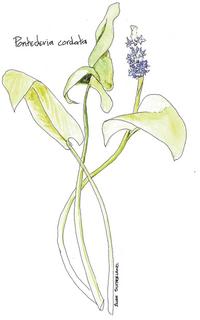FADE TO PURPLE

I am still banging on about blue, but nearly there. Did I say there were not so many plants with blue flowers? One worth a mention and especially suited to our climate is ceanothus or Californian lilac Ceanothus sp. as the common name suggests it is native to California and so is well adapted to our dry summers. Ceanothus usually forms a small shrub, but some specimens have a low ground hugging habit suiting them to ground cover. The plants need pruning after flowering to keep them from becoming too leggy and open in the middle.
There is another plant with unforgettable blue flowers and that is our own Chatham Island forget-me-not Myosotidium hortensia. This large herb has glossy green rhubarb shaped leaves and large heads of blue and white forget-me-not flowers, the clusters being about 10 to 15 cm across. Unfortunately it is a difficult plant for our dry summers and mild winters; I would be very interested if anyone has success with it here on our island. In Wellington at the Otari Plant Museum there are wonderful drifts of it growing beneath trees. My mother had some growing on the farm in the south Wairarapa, where they looked splendid at the end of the lawn beneath a tree and a golden privet hedge as backdrop.
Speaking of forget-me-nots, of course there are many bedding plants of blues shades including: Lobelia, aster, pansies, ageratum, campanula, polyanthus, anemone and larkspur to name a few. For the water there is pontideria pontideria cordata with arrow shaped leaves and spikes of blue flowers. This pond dweller can add a little vertical dimension. Another blue plant for the pond is a tropical water lily Nymphaea sp. This flower is sometimes used in the cut flower industry, but like so many ‘blue’ flowers it is really a little purple.
I think this is ok, as a strictly monochromatic border may be a touch on the boring or dull side. A mix of blue and bluish purple may be more interesting to the eye, throw in one yellow flower and the whole lot will sparkle, (yellow being the complimentary colour on the colour wheel, that is opposite) bringing all those blues to life. A note of caution though; be careful with yellow as it is what is known as an advancing colour. An advancing colour is one that will attract the eye first. This trick of the eye is sometimes used to create the allusion of distance. Putting advancing colours like yellow and red (also known as warm colours) to the fore ground and the blues to the distance, helps to increase the perceived length of a border. Another trick of the eye is to make the border or path slightly narrower at the far end increasing the sense of distance. Naturally if you look back from the other end your sense of distance will be foreshortened. These ploys I have to say are more commonly found in the larger gardens, but can apply to a smaller plot, so if you are contemplating a new border have a wee think about the use of colour and perspective and have fun.

0 Comments:
Post a Comment
<< Home